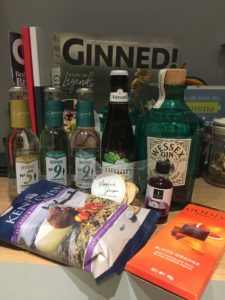 It’s September which means it is Craft Gin Club delivery time again! This month’s gin comes from Wessex Gin (along with a host of goodies including my fave cardamom tonic from Peter Spanton). Gin distilling is not a new venture for the founder of Wessex Gin, Jonathan Clark. Jonathan was the founder of the City of London Distillery (about 5 mins from my office, see my thoughts on the Six Bells gin and Square Mile gin) and when retirement didn’t suit him, he and his family decided to start all over again. The City of London Distillery is so ingrained in London, and when Jonathan and wife Gill moved to Wessex, they wanted that same connection to their surroundings. Having grown up in the countryside of Hampshire, we visited many a Roman/Saxon/Tudor sites thanks to school trips, and it’s this Anglo-Saxon time that inspired this gin. Specifically, the stories of King Alfred the Great, the man that scared off the Vikings (which was no mean feat). This era embraced the magic and the mystic, herbs were used for their healing properties and this has never really faded in the gin industry with a strong focus on the roots of their botanicals. The Anglo-Saxons were big on herbariums – a book listing herbs and their properties – and it is this that the Clark’s used to source their botanicals. Keen to make a classic London Dry gin which is heavy on the juniper, Jonathan also favours citrus led gins, with a hint of coriander and medicinal chervil, nowadays bringing an aniseed quality but also reportedly soothing stomach ailments – did you know King Alfred suffered from stomach problems with people thinking it was akin to Crohn’s Disease. So, how does it taste?
It’s September which means it is Craft Gin Club delivery time again! This month’s gin comes from Wessex Gin (along with a host of goodies including my fave cardamom tonic from Peter Spanton). Gin distilling is not a new venture for the founder of Wessex Gin, Jonathan Clark. Jonathan was the founder of the City of London Distillery (about 5 mins from my office, see my thoughts on the Six Bells gin and Square Mile gin) and when retirement didn’t suit him, he and his family decided to start all over again. The City of London Distillery is so ingrained in London, and when Jonathan and wife Gill moved to Wessex, they wanted that same connection to their surroundings. Having grown up in the countryside of Hampshire, we visited many a Roman/Saxon/Tudor sites thanks to school trips, and it’s this Anglo-Saxon time that inspired this gin. Specifically, the stories of King Alfred the Great, the man that scared off the Vikings (which was no mean feat). This era embraced the magic and the mystic, herbs were used for their healing properties and this has never really faded in the gin industry with a strong focus on the roots of their botanicals. The Anglo-Saxons were big on herbariums – a book listing herbs and their properties – and it is this that the Clark’s used to source their botanicals. Keen to make a classic London Dry gin which is heavy on the juniper, Jonathan also favours citrus led gins, with a hint of coriander and medicinal chervil, nowadays bringing an aniseed quality but also reportedly soothing stomach ailments – did you know King Alfred suffered from stomach problems with people thinking it was akin to Crohn’s Disease. So, how does it taste?
cocktail
Manly Spirits Coastal Citrus Gin
Note: The Manly Spirits team sent me a bottle to try, but as always I’ll let you know what I think.
 New South Wales is probably most famous for being the state that Sydney lies in on the south east coast of Australia. The Australian gin scene is growing rapidly (so much so that Junipalooza has expanded out there), and Manly Spirits started life in Tasmania in late 2015. Founders David and Vanessa discussed the possibility of opening a distillery and dedicated their time to researching successful distilleries around the world before commencing training with a distillery closer to home. They launched their own distillery in April and utilise the biodiversity that Australia has to offer. Their spirits are hand crafted – they don’t rely on a machine to work out when the head/heart/tail start and end, instead relying on the noses of their team. They forage for their marine botanicals with the help of renowned forager and chef Elijah Holland to ensure that everything is sustainably sourced. Their range now features two vodkas, a whisky currently sat ageing in barrels, a limoncello, a coffee liqueur and three gins. The gin we are trying today is the Coastal Citrus gin that features botanicals such as lemon aspen, sea parsley, meyer lemon, lemon myrtle and fresh coriander leaf. If the name alone didn’t connote that this was citrus led, then the botanical list certainly does. So, how does it taste?
New South Wales is probably most famous for being the state that Sydney lies in on the south east coast of Australia. The Australian gin scene is growing rapidly (so much so that Junipalooza has expanded out there), and Manly Spirits started life in Tasmania in late 2015. Founders David and Vanessa discussed the possibility of opening a distillery and dedicated their time to researching successful distilleries around the world before commencing training with a distillery closer to home. They launched their own distillery in April and utilise the biodiversity that Australia has to offer. Their spirits are hand crafted – they don’t rely on a machine to work out when the head/heart/tail start and end, instead relying on the noses of their team. They forage for their marine botanicals with the help of renowned forager and chef Elijah Holland to ensure that everything is sustainably sourced. Their range now features two vodkas, a whisky currently sat ageing in barrels, a limoncello, a coffee liqueur and three gins. The gin we are trying today is the Coastal Citrus gin that features botanicals such as lemon aspen, sea parsley, meyer lemon, lemon myrtle and fresh coriander leaf. If the name alone didn’t connote that this was citrus led, then the botanical list certainly does. So, how does it taste?
Taplin & Mageean Signature Gin
Note: The team at Taplin & Mageean sent me a bottle to try, as always I will let you know what I think.
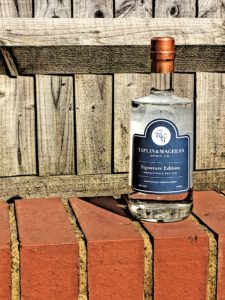 What is Taplin & Mageean gin?
What is Taplin & Mageean gin?
Taplin & Mageean gin has an unusual name, which for once doesn’t have a hidden meaning. It is simply the names of the founders – Chris Taplin and Barry Mageean. Chris met Barry whilst on a visit to the Yorkshire Distillery where Barry was head distiller. They got chatting, hosted a gin tasting and – as all good gin tastings end – ended with a conversation about making their own gin. They opened their distillery in Wensleydale (no, not the cheese), in an former train repair building at Leyburn station. As former head distiller, Barry put his skills to work developing their recipes and 49 trials later, they settled on the four that make up their range. I find it interesting that they launched with all four, the usual trick is to introduce one to market and then expand. Here, they have their signature gin which I am trying today, juniper heavy with Yorkshire hops, fresh grapefruit, flowers and spice, a peach and basil gin which also used apricots and vanilla, a spiced orange gin with winter flavours fig, cranberry and cinnamon, and finally a summery gin using elderflower, chamomile and apples. Despite being a new brand, the Signature Edition won a silver medal in the gin tasting category of the 2019 San Francisco Spirit Awards, so how does it taste?
Garden Shed Gin
Note: The Garden Shed Distillery team sent me a bottle to try, but as always I’ll let you know what I really think
Who are The Garden Shed Drinks Company?
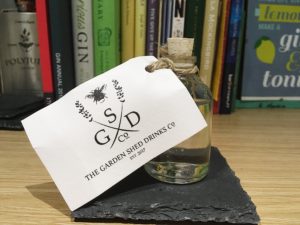 Based in Glasgow, the team have a strong ethical baseline. They donate a portion of their profits to environmental charities and they aim to raise awareness about some of the issues that exist due to climate change. With the classic tale of four friends that got together and after a few drinks decided to make a gin, they started this in their garden shed. They are inspired by the botanicals that grow around them – blackberries from their garden, dandelions that are usually disposed of and some bee friendly lavender. They bottle their gin at 45% and say it is filled with floral and spiced notes. So, how does it taste?
Based in Glasgow, the team have a strong ethical baseline. They donate a portion of their profits to environmental charities and they aim to raise awareness about some of the issues that exist due to climate change. With the classic tale of four friends that got together and after a few drinks decided to make a gin, they started this in their garden shed. They are inspired by the botanicals that grow around them – blackberries from their garden, dandelions that are usually disposed of and some bee friendly lavender. They bottle their gin at 45% and say it is filled with floral and spiced notes. So, how does it taste?
Mackintosh Gin
Note: Jim at Mackintosh Gin kindly sent me bottle to try, as always I’ll let you know what I think.
 The team at Mackintosh Gin come from Angus, the area just north of Dundee on the east coast of Scotland – affectionately known as “the birthplace of Scotland”. James and Deborah met and fell in love at a young age, after travelling aroujnd they settled in Angus and like all gin lovers, started attending gin festivals and building their gin collection. Around bottle 50, they joked that they should make their own gin – a joke that became reality two years later. They use nine botanicals in their gin – juniper, angelica, coriander and elderflower, which is picked a few minutes from their door. Each morning when they start a distillation, they go and buy fresh grapefruits from their local shop. They import their base spirit from the West Midlands, before the gin is distilled and bottled in Arbroath. Once off the still, it is combined with pure local water from Glen Isla.
The team at Mackintosh Gin come from Angus, the area just north of Dundee on the east coast of Scotland – affectionately known as “the birthplace of Scotland”. James and Deborah met and fell in love at a young age, after travelling aroujnd they settled in Angus and like all gin lovers, started attending gin festivals and building their gin collection. Around bottle 50, they joked that they should make their own gin – a joke that became reality two years later. They use nine botanicals in their gin – juniper, angelica, coriander and elderflower, which is picked a few minutes from their door. Each morning when they start a distillation, they go and buy fresh grapefruits from their local shop. They import their base spirit from the West Midlands, before the gin is distilled and bottled in Arbroath. Once off the still, it is combined with pure local water from Glen Isla.
Crofter’s Tears Gin
Note: The team at the Ice & Fire Distillery sent me a sample to try, but as always I’ll let you know what I think.
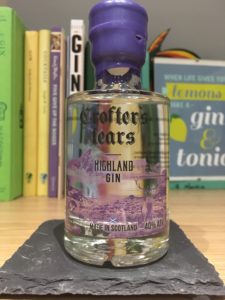 You might have read my review of Caithness Highland gin, and today’s gin also comes from the Ice & Fire Distillery. Crofter’s Tears uses purple heather as the signature botanical, alongside fresh orange and lime peel. The (full size) bottle reflects the contents with purple heather flowers snaking around the bottom of the bottle and on the neck stands tall a Highland stag. They suggest serving this with Mediterranean tonic and a twist of lime.
You might have read my review of Caithness Highland gin, and today’s gin also comes from the Ice & Fire Distillery. Crofter’s Tears uses purple heather as the signature botanical, alongside fresh orange and lime peel. The (full size) bottle reflects the contents with purple heather flowers snaking around the bottom of the bottle and on the neck stands tall a Highland stag. They suggest serving this with Mediterranean tonic and a twist of lime.
Caithness Highland Gin
Note: The team at the Ice & Fire Distillery kindly sent me a sample to try, but as always I’ll let you know what I think.
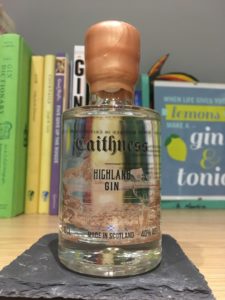 When you hear Ice and Fire, I don’t blame you for thinking about that little show Game of Thrones. But in this case, I’m referring to the Ice & Fire Distillery, a family of Crofters from the Scottish Highlands. Making the most of the beautiful land, they use local water and use purple heather as their signature ingredient in the Crofters Tears gin (review to come). The heather carries through to their branding, their bottles are surrounded by heather and embossed with a highland stag. The Caithness Highland gin that we try today uses rhubarb – a staple in a traditional crofting garden – along with salmonberries. No, not the fish, they are similar to raspberries and so called as traditionally they were eaten with salmon or salmon roe. They combine these with their other botanicals (lots of which are home grown) and put them in their pot stills in the shed, before hand bottling and labelling them.
When you hear Ice and Fire, I don’t blame you for thinking about that little show Game of Thrones. But in this case, I’m referring to the Ice & Fire Distillery, a family of Crofters from the Scottish Highlands. Making the most of the beautiful land, they use local water and use purple heather as their signature ingredient in the Crofters Tears gin (review to come). The heather carries through to their branding, their bottles are surrounded by heather and embossed with a highland stag. The Caithness Highland gin that we try today uses rhubarb – a staple in a traditional crofting garden – along with salmonberries. No, not the fish, they are similar to raspberries and so called as traditionally they were eaten with salmon or salmon roe. They combine these with their other botanicals (lots of which are home grown) and put them in their pot stills in the shed, before hand bottling and labelling them.
The Gael Gin
Note: I contacted the team at Gael gin and they kindly sent me a bottle to try, but as always I’ll let you know what I think.
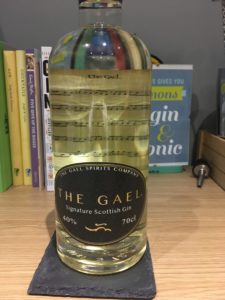 The Gael is an internationally acclaimed Scottish fiddle song that was originally composed for the Loch Ness visitor centre by Dougie MacLean, and since featured in the movie “The Last of the Mohicans”. When his son Jamie and his partner Tanya got together with gin lovers Nigel and Beverley, they wanted to find a way to combine their passions for gin and music. The Gael Gin team differ from the majority of gins as they distil their own base spirit (which in itself is fairly rare) with malted barley which gives the gin a deep, rich base note. Wanting to keep the Scottish connection strong, they use Scottish heather as one of their botanicals alongside juniper, lemon and orange peel, cardamom and coriander. Looking through the bottle shows you the sheet music for The Gael, and the yellow hue is instantly noticeable. So, how does it taste?
The Gael is an internationally acclaimed Scottish fiddle song that was originally composed for the Loch Ness visitor centre by Dougie MacLean, and since featured in the movie “The Last of the Mohicans”. When his son Jamie and his partner Tanya got together with gin lovers Nigel and Beverley, they wanted to find a way to combine their passions for gin and music. The Gael Gin team differ from the majority of gins as they distil their own base spirit (which in itself is fairly rare) with malted barley which gives the gin a deep, rich base note. Wanting to keep the Scottish connection strong, they use Scottish heather as one of their botanicals alongside juniper, lemon and orange peel, cardamom and coriander. Looking through the bottle shows you the sheet music for The Gael, and the yellow hue is instantly noticeable. So, how does it taste?
Kirkjuvagr Aurora Gin
Note: The team at Orkney Distilling kindly sent me a bottle of Aurora gin to try, but as always I’ll let you know what I think.
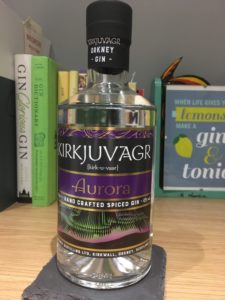 Back in May 2017, I tried Kirkjuvagr gin (pronounced kirk-u-vaar) and since then, the Orkney Distilling team have grown their range with a navy strength gin and two seasonal editions. Today we are trying their winter Aurora gin. Named after the Aurora Borialis, a phenomenon that appears in the sky over Orkney as winter draws in, this gin is inspired by cosying up by the fire – cinnamon, nutmeg and cloves bring a warmth alongside pink and black peppercorns. They recommend pairing this with ginger ale to amp up the spice. So, how does it taste?
Back in May 2017, I tried Kirkjuvagr gin (pronounced kirk-u-vaar) and since then, the Orkney Distilling team have grown their range with a navy strength gin and two seasonal editions. Today we are trying their winter Aurora gin. Named after the Aurora Borialis, a phenomenon that appears in the sky over Orkney as winter draws in, this gin is inspired by cosying up by the fire – cinnamon, nutmeg and cloves bring a warmth alongside pink and black peppercorns. They recommend pairing this with ginger ale to amp up the spice. So, how does it taste?
Kintyre Gin
Note: I contacted the Beinn an Tuirc distillery team and they kindly sent me some to try. As always, I’ll let you know what I really think.
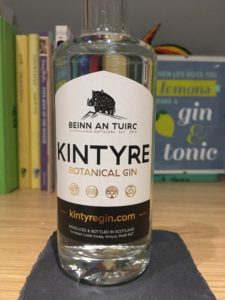 I think I speak for all of us when I say “what the hell does Beinn an Tuirc mean?” Well it’s the highest point in Kintyre that the Beinn an Tuirc distillery team sources their water from; it translates from gaelic as “the hill of the wild boar”. Kintyre gin features a (presumably) wild boar on top of a hill on their bottle and uses 12 botanicals – all of which are sustainably sourced. They combine macerating botanicals with vapor infusion and mix common botanicals orris root, lemon peel, liquorice, juniper and cubeb amongst others, with more unique ingredients Icelandic moss (which, confusingly, grows in Scotland and isn’t actually moss) and sheep sorrel (not made of sheep, adds a hint of floral notes). They power their 230 litre still with their own hydro-electric scheme and each batch is named, rather than numbers, using the Gaelic alphabet. They recommend serving this with Mediterranean Fever Tree and garnished with basil, or light tonic with mint.
I think I speak for all of us when I say “what the hell does Beinn an Tuirc mean?” Well it’s the highest point in Kintyre that the Beinn an Tuirc distillery team sources their water from; it translates from gaelic as “the hill of the wild boar”. Kintyre gin features a (presumably) wild boar on top of a hill on their bottle and uses 12 botanicals – all of which are sustainably sourced. They combine macerating botanicals with vapor infusion and mix common botanicals orris root, lemon peel, liquorice, juniper and cubeb amongst others, with more unique ingredients Icelandic moss (which, confusingly, grows in Scotland and isn’t actually moss) and sheep sorrel (not made of sheep, adds a hint of floral notes). They power their 230 litre still with their own hydro-electric scheme and each batch is named, rather than numbers, using the Gaelic alphabet. They recommend serving this with Mediterranean Fever Tree and garnished with basil, or light tonic with mint.